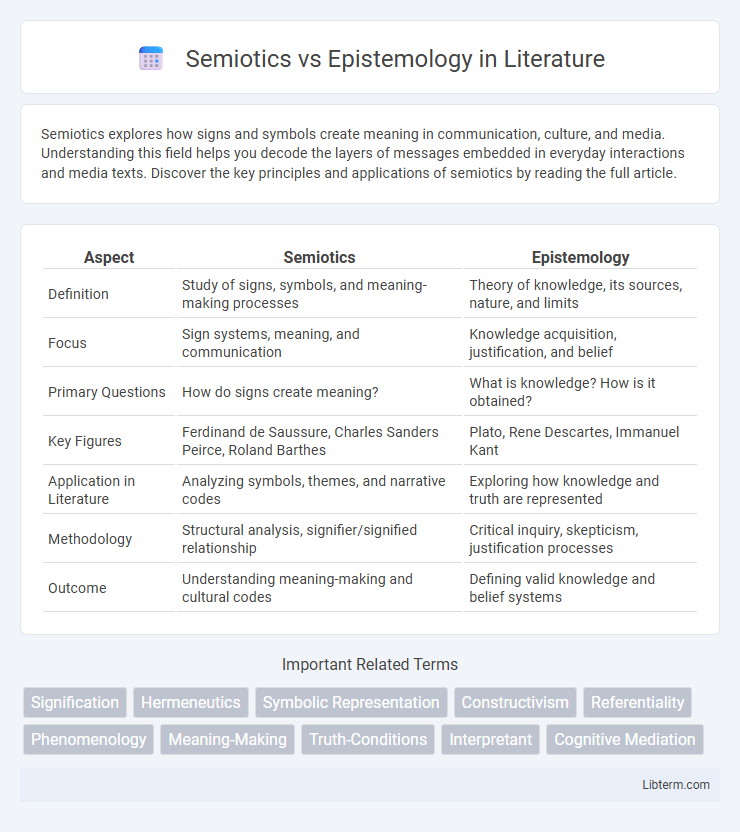Semiotics explores how signs and symbols create meaning in communication, culture, and media. Understanding this field helps you decode the layers of messages embedded in everyday interactions and media texts. Discover the key principles and applications of semiotics by reading the full article.
Table of Comparison
| Aspect | Semiotics | Epistemology |
|---|---|---|
| Definition | Study of signs, symbols, and meaning-making processes | Theory of knowledge, its sources, nature, and limits |
| Focus | Sign systems, meaning, and communication | Knowledge acquisition, justification, and belief |
| Primary Questions | How do signs create meaning? | What is knowledge? How is it obtained? |
| Key Figures | Ferdinand de Saussure, Charles Sanders Peirce, Roland Barthes | Plato, Rene Descartes, Immanuel Kant |
| Application in Literature | Analyzing symbols, themes, and narrative codes | Exploring how knowledge and truth are represented |
| Methodology | Structural analysis, signifier/signified relationship | Critical inquiry, skepticism, justification processes |
| Outcome | Understanding meaning-making and cultural codes | Defining valid knowledge and belief systems |
Introduction to Semiotics and Epistemology
Semiotics studies signs and symbols as fundamental elements of communication, exploring how meaning is constructed and interpreted through signifiers and the signified. Epistemology investigates the nature and scope of knowledge, focusing on how humans acquire, justify, and validate beliefs and truths. The introduction to semiotics emphasizes understanding the relationship between language, culture, and cognition, while epistemology centers on analyzing the sources, limits, and certainty of knowledge.
Defining Semiotics: The Study of Signs
Semiotics is the study of signs and symbols, exploring how meaning is created and communicated through linguistic, visual, and cultural systems. It analyzes signifiers, the forms of signs, and signifieds, the concepts they represent, to understand how interpretation arises in various contexts. This field contrasts with epistemology, which focuses on the nature and scope of knowledge rather than the mechanisms of meaning-making.
Understanding Epistemology: Theory of Knowledge
Epistemology examines the nature, origin, and scope of knowledge, focusing on how we acquire, justify, and validate beliefs. It explores concepts such as justification, truth, and belief, addressing questions about what distinguishes knowledge from opinion. Unlike semiotics, which studies signs and meaning-making processes, epistemology centers on understanding the foundations and limits of human knowledge.
Historical Origins: Semiotics vs Epistemology
Semiotics originated in the early 20th century, with key figures such as Ferdinand de Saussure and Charles Sanders Peirce establishing foundational theories on signs and symbols as units of meaning. Epistemology dates back to ancient philosophy, with roots in Socratic and Platonic inquiries into knowledge, belief, and justification. While semiotics investigates how meaning is constructed and communicated through signs, epistemology focuses on the nature, sources, and limits of human knowledge.
Key Concepts and Terminologies
Semiotics centers on the study of signs, symbols, and their meanings within communication systems, emphasizing concepts such as signifier, signified, denotation, and connotation. Epistemology, by contrast, investigates the nature and scope of knowledge, focusing on key terminologies like justification, belief, truth, and skepticism. Understanding the interplay between semiotic signs and epistemological foundations reveals how meaning is constructed and validated in human cognition.
Methods of Inquiry: Comparative Analysis
Semiotics investigates meaning through signs and symbols, analyzing how they create and convey messages within cultural and communicative contexts. Epistemology examines the nature and scope of knowledge by questioning how knowledge is acquired, validated, and distinguished from belief. Comparative analysis reveals that semiotics employs interpretative methods focusing on sign systems, while epistemology relies on critical reasoning and empirical validation to understand knowledge formation.
Influence on Communication and Meaning
Semiotics studies signs and symbols as fundamental units of meaning in communication, emphasizing how meaning is constructed and interpreted through cultural codes. Epistemology examines the nature and scope of knowledge, influencing communication by questioning how knowledge is acquired, justified, and transmitted. The interaction between semiotics and epistemology shapes meaning by linking symbolic representation with the processes of understanding and validating knowledge in communication contexts.
Application in Contemporary Disciplines
Semiotics, as the study of signs and symbols, plays a crucial role in media studies, linguistics, and marketing by decoding meaning and communication patterns. Epistemology, the investigation of knowledge origin and limits, guides research methodologies and critical thinking across philosophy, cognitive science, and information technology. Contemporary disciplines leverage semiotics for interpreting cultural texts and epistemology for validating knowledge frameworks, enhancing analytical precision and interdisciplinary innovation.
Overlapping Themes and Contrasts
Semiotics examines the study of signs and symbols as fundamental elements of communication, while epistemology focuses on the nature, origin, and limits of knowledge itself. Both disciplines intersect in exploring how meaning is constructed and understood, with semiotics analyzing the mechanisms of signification and epistemology addressing the validation and justification of knowledge claims. Contrasts arise as semiotics prioritizes the interpretive processes within language and culture, whereas epistemology emphasizes the criteria and methods for acquiring true knowledge.
Conclusion: Bridging Signs and Knowledge
Semiotics explores how signs and symbols create meaning, while epistemology investigates the nature and scope of knowledge itself. Bridging these fields reveals how understanding signs enhances the process of acquiring and validating knowledge. This intersection underscores the pivotal role of interpretation in shaping both communication and cognition.
Semiotics Infographic

 libterm.com
libterm.com